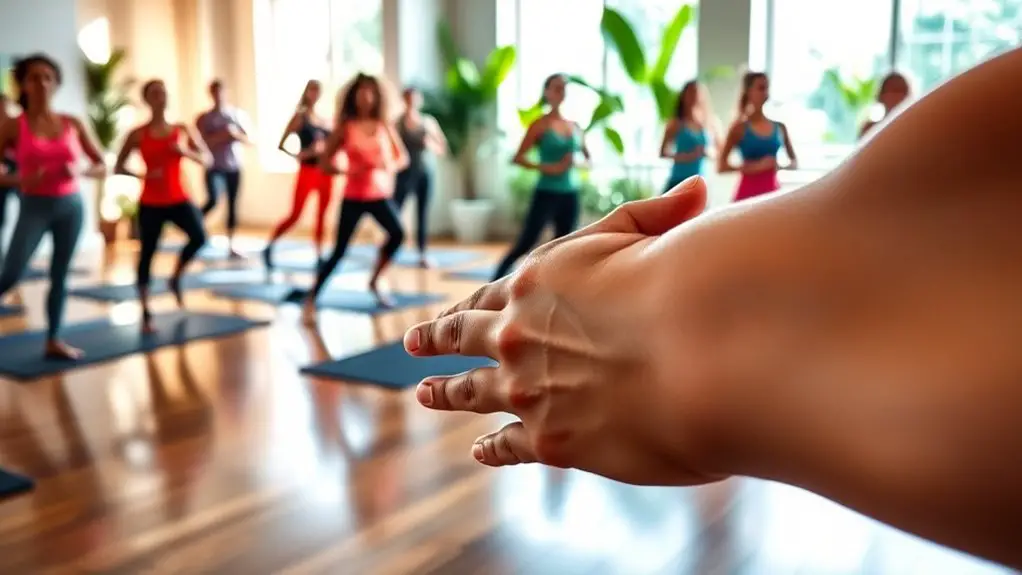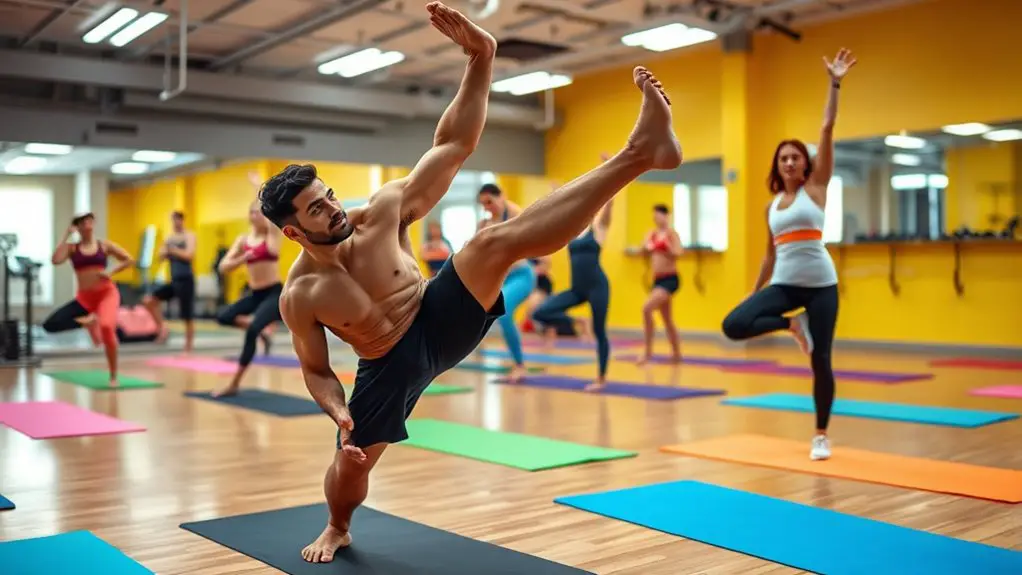Yoga's great for athletic recovery. It enhances flexibility and range of motion, letting you move more freely. You'll find it reduces muscle tension and soreness, helping you recover faster. Plus, improved breathing boosts oxygen flow, while mindful practices sharpen your focus. Emotional balance and resilience grow, aiding stress relief. By integrating yoga into your routine, you'll support injury prevention and rehabilitation. There's so much more to discover about how yoga can elevate your recovery experience.
Enhancing Flexibility and Range of Motion
When you incorporate yoga into your routine, you're not just adding another workout; you're enhancing your flexibility and range of motion, which are essential for athletic performance. Imagine flowing through poses that stretch your muscles and joints, allowing you to move more freely. This newfound freedom translates to better strides in running, improved agility in sports, and a more fluid overall performance.
With regular practice, you'll notice that your body feels less restricted, making it easier to tackle those challenging movements. You'll gain access to deeper stretches that open up tight areas, liberating you from the usual limitations. As your flexibility improves, you're not just preventing injuries; you're also releasing your potential for explosive movements and dynamic play. Additionally, mobility training complements yoga by further enhancing range of motion and movement efficiency.
Reducing Muscle Tension and Soreness
As you engage in intense training or competition, muscle tension and soreness can quickly become unwelcome companions. Fortunately, yoga offers a pathway to relief. By incorporating targeted stretches and poses, you can alleviate tightness and promote relaxation in your muscles. Through mindful movements, yoga helps release built-up tension, allowing your body to recover more effectively.
When you practice yoga, you focus on deep stretching and gentle poses that target specific muscle groups. This not only helps to reduce soreness but also encourages a greater sense of freedom in your body. You'll find that your muscles feel more relaxed and supple, enabling you to return to your athletic pursuits with renewed energy.
Moreover, the mental aspect of yoga fosters a sense of calm, which can further enhance your recovery. By practicing poses such as Child's Pose, you can effectively ease muscle tension and promote a deeper state of relaxation. Embrace the power of yoga to diminish muscle tension and soreness, revealing your body's full potential for performance and enjoyment.
Improving Breathing and Oxygen Flow
While you push your body to its limits during training, maintaining proper breathing can often take a backseat. However, focusing on your breath can greatly enhance your performance and recovery. Yoga teaches you to harness your breath, improving oxygen flow to your muscles and helping you feel more liberated in your movements. Incorporating proper nutrition strategies is vital for enhancing muscle recovery after intense training.
| Breath Technique | Benefits | Yoga Poses |
|---|---|---|
| Diaphragmatic | Increases lung capacity | Child's Pose |
| Ujjayi | Calms the mind | Warrior II |
| Nadi Shodhana | Balances energy | Bridge Pose |
| Kapalabhati | Energizes the body | Downward Dog |
Boosting Mental Focus and Clarity
When you're training hard, mental clarity can make all the difference in your performance. Yoga offers techniques that enhance concentration and provide stress reduction strategies, helping you stay focused during intense workouts and competitions. By incorporating these practices, you can sharpen your mind and improve your athletic skills. Additionally, meditation enhances mental conditioning which can further contribute to your overall performance.
Enhanced Concentration Techniques
Enhancing your concentration can greatly impact your athletic performance and recovery. When you practice yoga, you learn to focus on your breath and movements, sharpening your mental clarity. This mindfulness helps you stay present during workouts and competitions, allowing you to tap into your full potential. Techniques such as pranayama, or breath control, can improve your focus by centering your thoughts and reducing distractions. Additionally, incorporating meditation into your routine can foster a deeper connection with your body, enhancing your awareness of physical cues. By committing to these practices, you'll not only boost your concentration but also cultivate a sense of freedom in your movements, enabling you to perform at your best and recover more effectively.
Stress Reduction Strategies
To effectively manage stress and enhance mental focus, incorporating yoga into your routine can be a game changer. Yoga teaches you to breathe deeply and stay present, creating a powerful antidote to daily pressures. Through poses and mindfulness, you'll learn to let go of tension and cultivate a sense of calm that spills over into other areas of your life.
Promoting Emotional Balance and Resilience
When you practice yoga, you're not just stretching your body; you're also nurturing your emotional well-being. By incorporating stress reduction techniques and enhancing your mind-body connection, you can improve your emotional regulation. This balance can make a significant difference in your overall resilience as an athlete. Additionally, the practice of yoga cultivates deeper awareness of your thoughts and feelings, which enhances your ability to manage stress effectively.
Stress Reduction Techniques
While you may push your physical limits during training, it's crucial to address the emotional toll that intense workouts can take. Implementing stress reduction techniques can help you maintain emotional balance and resilience. Here are four effective methods to evaluate:
- Mindful Breathing: Focus on your breath to center your thoughts and release tension.
- Meditation: Dedicate time to quiet your mind and cultivate inner peace.
- Progressive Muscle Relaxation: Tense and relax different muscle groups to alleviate stress.
- Yoga Nidra: Engage in deep relaxation techniques that promote restorative rest and recovery.
Enhanced Mind-Body Connection
Building on the importance of stress reduction, an enhanced mind-body connection can greatly promote emotional balance and resilience in athletes. When you practice yoga, you're not just stretching; you're tuning into your body's signals and feelings. This awareness helps you recognize emotional patterns and reactions, fostering a sense of freedom from stress and anxiety. By connecting breath with movement, you create a harmonious flow that encourages mindfulness. This practice allows you to release pent-up emotions, providing a safe space to explore your inner self. As you cultivate this connection, you'll find it easier to adapt to challenges, bounce back from setbacks, and maintain your focus, ultimately enhancing your overall performance and well-being. Embrace this journey of self-discovery and empowerment.
Improved Emotional Regulation
As you engage in yoga, you may find that your ability to regulate emotions improves considerably. This practice cultivates emotional balance and resilience, allowing you to navigate life's ups and downs with greater ease. Here are some ways yoga promotes emotional well-being:
- Mindfulness: It encourages present-moment awareness, reducing anxiety and stress.
- Breath Control: Deep, intentional breathing calms your nervous system, helping you manage overwhelming feelings.
- Self-Awareness: You'll become more attuned to your emotional triggers, enabling proactive responses rather than reactive ones.
- Community Connection: Practicing with others fosters a sense of belonging, providing support during challenging times.
Embracing yoga isn't just about physical recovery; it's a pathway to emotional freedom and stability.
Supporting Injury Prevention and Rehabilitation
Incorporating yoga into your training routine can greatly enhance injury prevention and rehabilitation efforts. This practice not only improves flexibility and strength but also helps you develop body awareness, essential for recognizing your limits. By enhancing your range of motion, yoga allows your muscles and joints to perform better, reducing the risk of injuries. Additionally, practicing yoga can complement your efforts in preventing sprains and strains, allowing for a more comprehensive approach to athlete wellness.
| Yoga Benefits | Impact on Injury Prevention |
|---|---|
| Increased flexibility | Reduces muscle strain |
| Improved core strength | Stabilizes joints |
| Enhanced body awareness | Prevents improper movement patterns |
Practicing yoga regularly encourages a balanced approach to your workouts, helping you stay in tune with your body's needs. When recovering from an injury, gentle yoga can aid in rehabilitation, promoting circulation and healing. So, embrace yoga as an essential part of your athletic journey to stay strong, free, and injury-free.
Encouraging Mindfulness and Stress Relief
Yoga isn't just about physical strength; it also plays a significant role in cultivating mindfulness and relieving stress. When you're immersed in your practice, you can experience a profound sense of freedom and peace. Here are some key benefits:
- Enhanced Focus: Yoga encourages you to center your thoughts, improving concentration both on and off the mat.
- Emotional Balance: Through mindful breathing and movement, you can release tension and promote emotional stability.
- Improved Sleep: Regular practice can lead to better sleep quality, helping you feel refreshed and ready for the day. This is crucial, as quality sleep supports muscle recovery and readiness for performance.
- Stress Reduction: By connecting with your breath and body, you can lower cortisol levels, leading to a calmer state of mind.
Embracing these elements can transform your recovery journey, allowing you to not only heal but thrive. So, why not explore how yoga can help you find that much-needed balance?
Integrating Yoga Into an Athletic Training Routine
While many athletes focus solely on strength and endurance, integrating yoga into your training routine can enhance overall performance and recovery. By adding just a few sessions each week, you'll increase flexibility, reduce injury risk, and improve mental clarity—allowing your body and mind to work in harmony.
Here's a simple guide to help you integrate yoga into your routine:
| Yoga Pose | Benefit |
|---|---|
| Downward Dog | Improves hamstring flexibility |
| Warrior II | Builds strength and balance |
| Child's Pose | Promotes relaxation and recovery |
| Pigeon Pose | Opens hips and releases tension |
| Bridge Pose | Strengthens back and core |
Start with short sessions, focusing on your breath and movement. Over time, you'll notice not just physical improvements but also a greater sense of freedom in your athletic pursuits. Embrace the journey!
Frequently Asked Questions
How Often Should Athletes Practice Yoga for Optimal Recovery?
You should aim to practice yoga at least two to three times a week for ideal recovery. This frequency helps maintain flexibility, reduce muscle tension, and promote relaxation, allowing your body to recover more effectively.
Can Yoga Replace Traditional Stretching Routines for Athletes?
Yoga can complement traditional stretching, but it shouldn't fully replace it. You'll find that integrating both helps improve flexibility and recovery, allowing you to explore new movement possibilities while enjoying the freedom of varied practices.
What Types of Yoga Are Best for Athletic Recovery?
When it comes to yoga for recovery, gentle styles like Hatha and Yin are your best bets. They'll help you unwind, increase flexibility, and promote relaxation, giving you that freedom to bounce back stronger.
Are There Specific Yoga Poses for Different Sports?
Absolutely, there're specific yoga poses tailored for various sports. For instance, runners benefit from hip openers like pigeon pose, while cyclists can focus on back stretches like cat-cow. Customize your practice to enhance performance and flexibility!
How Long Should a Yoga Session Last for Recovery Benefits?
If you think a five-minute yoga session can magically transform your recovery, think again! Aim for at least 30 to 60 minutes to truly experience the freedom and rejuvenation your body craves. You won't regret it!




